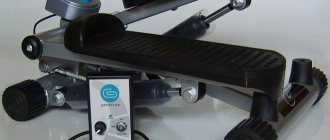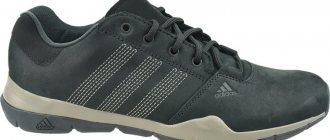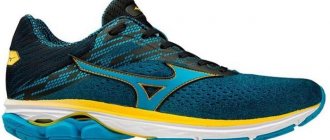Nordic walking poles are an integral attribute of the technique, without which its meaning is lost. Northern or Nordic walking was born in the Scandinavian countries, where skiers decided to go out for training with ski poles in the summer. Many years later, the activity grew into an independent sport, popular throughout the world.
The difference between Finnish walking poles and ski and trekking poles
The answer to the question “how to choose the right poles for Nordic walking” is banal: choose poles specifically for walking, not for skiing or trekking.
Trekking - hiking in the mountains - involves steep and long ascents and descents. At the same time, in both cases, sticks are used as support; a person, as it were, clings to the slope with them, without throwing his arm back with a relaxed hand, as in Finnish walking. “The main mistake that beginners can make is to confuse Nordic walking poles with trekking poles,” says Daniil Lobakin, candidate master of sports, PRO expert at Sportmaster PRO. — The handle of the trekking poles has ergonomic grooves and finger rests. This is necessary when we are trekking down a mountain and can use a pole as a support. In Nordic walking, poles work on a different principle.” So the specialized shape of the handle for mountains can only get in the way.
In addition, only telescopic poles are used for trekking, in order to shorten them on the ascent and extend them to a greater length on the descent. There are also similar poles for Nordic walking, but the entire training takes place at the same length. Plus, the material of a “Scandinavian” pole should dampen vibrations, but trekking poles don’t care about this - this is not necessary, since the pole is stuck in all the time and not placed on the surface.
With ski poles, they stand higher than the ground due to the thickness of the skis and the soles of the boots, plus the movement is performed with a completely different technique, intensity and speed. Therefore, they are longer than the Scandinavian ones by an average of 20-30 cm. With them, you will at least overload your arms, shoulders, neck and lower back, or even injure them. And keep in mind that these poles do not have a boot tip; they are designed to be fixed in the snow.
Reviews
Maria Fedorovna, 56 years old. KV+Vento poles for testing I liked them: they have a good grip, the material on the handle is non-slip, the lanyard is Velcro and can be removed instantly at the press of a button. Convenient when the phone rings or I want to drink tea. I carry a thermos with me in my backpack when I walk along the Volga embankment. In my opinion, I got quality sticks. The knee does not hurt when walking with them, but without them it hurts. My granddaughter said that they are strict and stylish, like me...
Nikolai, 49 years old. I work and can afford to train in the summer with solid Scandinavian poles - I am an experienced skier. I even wanted to buy folding Leki, but the store manager drew my attention to the Finnish Exel Nordic Traine. He said that they were of high quality and that you could train on different terrain. That's right, wonderful sticks! I walk on the beach with a ring, and on the cobblestones in the park with rubber heels. Everything fits tightly and does not slip. They feel like feathers in your hands and have a great spring to them. Lanyards are multi-handed. I advise you to fork out more, but the pleasure and benefits are great.
How to choose the right poles for Nordic walking
“Nordic walking poles are divided into two main types – adjustable (folding) and non-adjustable (solid),” says Daniil Lobakin. Accordingly, the first ones are universal and can be adjusted to any height, while the second ones should be chosen for yourself.
Telescopic poles are good if:
- You need to take them with you by public transport, train or plane. Such sticks fold up to 30-40 cm, and the length of solid ones will be about 90 cm or more.
- There is no place to store long poles.
- The size of non-adjustable ones is not suitable for you: they have a pitch of 5 cm (95-100-105 cm, etc.), and you, for example, need a height of 103 cm.
- You are not sure about the correct length or the store does not have your size.
- You want to vary the load, sometimes lengthening the poles by 3-4 cm.
- You plan to alternate between walking and running and want to stow your poles so they don't interfere with your running.
Of course, the fact that the stick is not solid, but has joints, affects its service life. At the joints, over time, the stick tubes will wear out slightly and begin to rotate or slide. It’s unpleasant when training is constantly interrupted in order to tighten the fixation points. However, even folding poles have a 2-year warranty (does not include breakage due to a fall or loss of tips).
“To begin with, I recommend taking sliding poles,” advises Denis Lobakin. — They differ in the fixation system, there are two of them - a collet mechanism and an eccentric one. The second option is more convenient and durable.”
We look at the warranty period
It goes without saying that you should choose a seller who gives a guarantee in principle. At the same time, you should pay attention to models with a long warranty period of 1 year or more, especially if you purchase folding poles.
☝ Our store provides a 100% possibility of returning the cost or exchanging goods within 24 months in case of detection of a factory defect (loss of tips is not a factory defect).
Now you are ready to buy!
How to adjust the poles to this length?
- Turn the lock between the sections according to the arrow indicating the direction of opening;
- Pull out the down tube and adjust the height as the expert above advises;
- Screw the fastener back;
- Repeat the operation with the second stick, placing it against the first one on the floor or horizontal surface to determine the length;
- Make a few pushes off the floor with sticks and check the tightness of the clamps again.
When the load during the lesson becomes higher and more intense, you will feel that you need solid poles.
Hitch
At the end of the workout, the muscles are warmed up - and this is the right time to stretch. Do some stretching exercises for your back, shoulders, hips, and calves. It is important to slow down, go into relaxation mode and switch your heart from an elevated heart rate to a normal one.
After the first workouts, it is useful to visit the sauna: the procedure will help slow down the synthesis of lactic acid - the muscles will hurt less, the metabolism will speed up, and relaxation will occur.
During training, you can combine slow and fast segments, wide and small steps, combine walking with short runs, physical exercise and even breaks.
Nordic walking poles: sizes by height
“Unregulated poles are selected according to size depending on height,” reminds Daniil Lobakin. You can choose the size directly in the store according to the principle described above: standing vertically with your elbow pressed to the body. Or choose the size according to the table.
| Height, cm | Entry level (lower possible) | Fitness | Advanced level |
| Up to 165 | Up to 95 | 110-115 | 115-120 |
| 166-170 | 100 | 115-120 | 120-125 |
| 171-179 | 105 | 120-125 | 125-130 |
| 180-189 | 110 | 125-130 | 130-135 |
| 190 and above | 115 | 130-145 | 135-140 |
You can also calculate the length of the sticks using the formula: a person’s height in centimeters multiplied by 0.6 or 0.7. Beginners need shorter poles (multiply height by 0.6), advanced practitioners, for example, former skiers, need longer poles (multiply by 0.65 or 0.7).
Stick design
Like a ski or trekking pole, a Finnish walking pole consists of three structural elements:
- The tube (called a tree or trunk) is the stick itself;
- Set of handle (or handle) and lanyard;
- Tip (nozzle or foot).
What do you need to know about these details when choosing poles?
Tube Material:
- Fiberglass (or fiberglass) is fragile, does not dampen vibration, and is relatively resistant to breakage (if dropped). Average weight (200-300 per pair).
- Aluminum - does not break when dropped, vibration damping depends on the quality of the material. Relatively heavy sticks (a pair weighs 400-500 g).
- Carbon fiber (carbon) is the lightest material (weight of a pair is up to 200 g), dampens vibration, is durable when stuck in, but not resistant to fracture. Poles can contain up to 50 to 100% carbon; the most practical in terms of strength and lightness are tubes with 60-80% carbon.
The handle is also made of different materials. “It can be neoprene, plastic or cork,” explains Daniil Lobakin. “Cork ones are the most comfortable: in cold weather they won’t slip like plastic and won’t get wet like neoprene.”
The lanyard can be made either in the form of a loop or in the form of a trap (sometimes called a glove). The second option is a design that comfortably fits the palm and wrist. With it, you don’t need to hold the stick with force, since the main load of holding the stick falls on the lanyard. Moreover, with it, when throwing your arm back, you will be able to fully open your palm and relax your fingers, which is an important element of arm work in Finnish walking. “This design of the lanyard prevents the stick from falling out,” our expert clarifies. “A glove trap with the ability to unfasten is more ergonomic and more convenient, because the stick is held on the hand and does not need to be removed, each time pulling the hand through the lanyard.”
The tips on the sticks can be supplemented or replaced. “The tips are made mainly of metal,” says Daniil Lobakin. — For walking on asphalt, a rubber boot attachment is screwed onto them. In winter, the attachments are removed and feet are added - wide stops that prevent the poles from falling into the snow.” If you often walk with poles, you can purchase spare rubber tips, since they wear out quickly on asphalt. As an additional accessory, you can purchase fitness gloves for cool summer weather, and for winter, thin but warm cross-country ski gloves are suitable.
Nordic walking poles: how to choose from popular models
High-quality Nordic walking poles are made by leading ski pole manufacturers: EXEL, OneWay, Swix, Leki, KV+ and others. Here are a few examples from the range:
- Vinson/Vinson Plus is one of the most popular models of the 2020/2021 season. Telescopic poles with cork handles have a built-in Anti-shock shock absorber that dampens vibration when hitting the asphalt. The model is perfect for beginner Nordic walkers.
- KV+ Zaluna Clip - telescopic two-section poles with a neoprene handle and a detachable half-glove lanyard. Made of aluminum, they are not afraid of accidental falls on the asphalt and impacts, allowing beginners to master the technique efficiently and pump up their arms due to their weight of 480 g.
- One Way TeamFinlandPRO 60% Carbon is the leader among carbon poles for the 2020/2021 season. Lightweight, perfectly vibration-absorbing, one-piece designs for people who already have experience in this type of fitness.
- The Ergo Pro 100% Carbon is a super lightweight foldable model with an all carbon fiber tube. Sticks are considered orthopedic, as exercising with them straightens posture and improves the condition of the spine. For any level of training.
How much do the poles cost?
When choosing Nordic walking poles, always read the model description. It indicates for what level of students this pair of poles is suitable. This is important, since poles for advanced amateurs are stiffer, but more fragile to break. An inexperienced walker can, after training, lean such poles against a fence, a gust of wind will blow them onto the asphalt, and the tube will crack.
- Entry-level poles cost around 1,000 – 2,500 rubles.
- Fitness-level poles will cost from 3,000 to 10,000 rubles, with an average of 5,000 to 7,000 rubles.
- Professional poles cost an average of 14,000 - 15,000 rubles. The price range is from 10,000 to 40,000 rubles or more.
“The high-budget segment includes folding carbon poles with high-quality mechanisms,” explains Daniil Lobakin. - They can be ultra-compact - four-section. A special storage regime for all poles is not required, as well as lubrication of the mechanisms; a cover is enough.”
Where to begin?
The golden rule of any workout is to start with a warm-up. 10-12 minutes are enough to warm up your muscles and joints. Pay attention to your entire body, starting from your neck to the tips of your feet - this will protect you from the risk of sprains that happen “in cold weather” and prepare your heart for stress.
Before training, also be sure to check the condition of the fastenings and adjust the length of the straps holding the poles in your hands.
What should you not do when buying poles?
Beginners often make common mistakes. How to avoid them?
- Don't buy your first poles without holding them in your hands. If it’s cheaper to order online, first go to a showroom or offline store.
- Don’t buy the first ones you come across, pick up several models.
- Don't expect your first pair of poles to last long. Very often, beginners break them in the process of getting used to and mastering the technique.
- Learn to use your hands correctly, regardless of the quality of your poles and lanyards.
- Progress in equipment as gradually as in preparation! In other words, you can start with a simple model made of cheap material. But the better, longer and more active you walk, the higher the level of pole you should buy.
The main rule is that the equipment should be comfortable for you personally and pleasing to the eye. Then the classes will be successful and bring you pleasure.
We look at the handle and lanyard
Correct Nordic poles should have lanyards-half-gloves with Velcro, they are also called “traps”. Such devices are necessary to reduce the load on the joints, evenly distribute the pressure when pushing, and firmly fix the hand. You don't need to squeeze the handle because your palm is already secured with a lanyard!
Choosing a comfortable lanyard is a very individual matter. The “trap” should not be too loose, but at the same time it should be comfortable for the hand, and the sensations should be natural.
Here it is worth paying special attention to the fabric, quality of tailoring and fastening. So, when choosing in a store, take your time: insert your hand into the lanyard, grasp the handle, move your hand and evaluate the comfort.
Now it is possible to purchase poles with removable and non-removable lanyards.
If it is important for you to be able to get something out of your pocket or bag, tie your shoelaces, pick up poles during the warm-up process, or quickly answer a phone call during class, then a model with a removable lanyard will suit you, for example, Finpole Star quick-release, solid Era 30 % Carbon, compact Finpole Alpina T3.
The best models have a handle made of cork. Its advantage over a plastic handle is good thermoregulation: in winter it will not be cold to hold the poles, and in summer the cork prevents your palms from sweating. The rubberized handle will also cope with the cold, but in the summer it will not help with the slipping of a sweaty palm.











